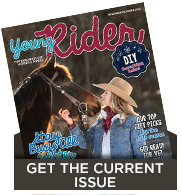If you’re in the market for a horse, there’s one breed you’ll see frequently on sale websites—Thoroughbreds. Why? Because thousands of them are bred each year for the racing industry, but very few of them are successful on the track. What happens to the unsuccessful ones? Lucky ones end up with young riders like you. Unlucky ones end up at horse sales and face uncertain futures.
Not every Thoroughbred will make a good horse for a young rider, but with proper handling and training, many Thoroughbreds can become wonderful riding horses. They just need special handling when they first come off the track.
If you’re considering buying or adopting an ex-racehorse, it’s important to have a great trainer to help you in the first year or two with your new horse. It’s essential to have someone on the ground who is experienced with ex-racers and who can give you advice every step of the way. Here are a few tips to make training and riding your off-the-track-Thoroughbred a safe and happy experience for both of you.
Right Off the Track
If your horse is right off the track, it’s best to give him a few weeks vacation so he can get used to his new surroundings. It can take around 30 days for high-powered vitamins and drugs to work their way out of his body. Let him “chill out” for a while and get used to your barn’s routine before you hop on him.
If he’s been living at an equine charity for a few months (or longer), give him at least a week to get used to you and his new home before you ride him. You’ll be glad you did, because he’ll probably be more relaxed when you eventually jump on board.
First Ride
During your newbie’s vacation, lead him around the farm so he can look at his surroundings. Walk him around the arena so he learns that jumps, poles and gates aren’t scary monsters. Stay relaxed so he stays relaxed. Taking the time to introduce your Thoroughbred to the farm should make your first few rides less stressful for both of you.
When you ride your horse for the first time, ask an experienced horsey friend or your trainer to hang out with you in case you need help. Grab a body protector (borrow one if you don’t have one) for your first few rides, and always wear a safety helmet.
Mounting
Jockeys at the track are given a leg up by a person on the ground when they mount, so your horse will not be used to someone putting her foot in the stirrup and pulling herself up. He will probably not stand still for that.
Your friend on the ground should fasten a lunge line to your horse’s bit and hold on to him when you mount. Use a mounting block for the first few weeks until your horse understands what’s going on. If he fidgets, hop off immediately and have the person on the ground back him up and then line him up again next to the mounting block.
Get on your horse quietly and sit down gently in the saddle so you don’t startle him.
Moving Forward
Once you’re safely in the saddle, ask your horse to walk forward by putting a little pressure on his sides with your lower legs. At the same time, your trainer should lead him forward. Racehorses are used to be being led, so this should be easy for him. You may want him to be led for several rides—it just depends on his behavior. Your trainer should lead you round the arena several times keeping a loose hold on the lunge line, but you should steer your horse. Your trainer is only hanging on in case there’s a problem. Walk around jumps and over poles. Ask your horse to halt and stand still several times.
If your horse is doing great, your trainer can set you free!
On Your Own
It’s a good idea to stick to the walk for your first few rides on your new ex-racer. You can do many things at the walk. Ride lots of circles. Spiral in and out. Walk over poles. Do serpentines. Encourage your horse to bend. When Thoroughbreds come off the track, they are usually stiff as boards. They don’t bend! It will take time to help your horse be suppler.
Once your newbie is comfortable in the arena, you can think about trotting and cantering.
Remember that many ex-racers go faster when you shorten your reins, so for the first few months of riding your horse try to keep the reins slightly loopy. Do your best to avoid pulling on his mouth. Keep your hands light as a feather.
Cantering an ex-racer can often be an “exciting” experience. Your horse may be very unbalanced at first and he may speed up. Trot on a 20-meter circle in the corner of the arena, and when he’s calm and fairly balanced give him the cues to canter. Try your best to keep your reins looped and your hands soft. You don’t want to yank him in the mouth as he jumps forward. Sit slightly forward, off his back, and canter him two or three times around the circle and then bring him back to a trot. Don’t overdo it.
Wrong Lead!
It’s critical to remember that most racehorses rarely canter to the right. Why? Because they race to the left on the track. Very few racehorses are schooled like riding horses in an arena, so cantering to the right will feel strange to them. It may take a while to get your horse to take the right lead, so be patient. You may need your trainer to give you some tips about how to get him to take the correct lead.
Passing By
Nori Scheffel, a Paris, Ky., trainer who has worked with lots of off-the-track- Thoroughbreds says that teaching an ex-racer how to pass other horses right from the start is very important.
“They must learn how to walk, trot and canter by other horses calmly, because they’ll need to do this in lessons and at shows,” says Nori.
Ask a pal to ride her horse in front of you, behind you and next to you. Then ride in different directions and pass each other several times. Do this whenever someone else is in the arena. Do your best to keep your horse focused on working—not on the other horse.
Hit the Trails
When you feel totally comfortable on your ex-racer in the arena, you can try going on a trail ride. It’s so important to get your horse out of the arena. Too much schooling can make him sour.
Before you head out on your first trail ride, ride your horse for a while in the arena to get rid of excess energy. Then ask a friend with a super-quiet horse to accompany you on the ride. Stick to walking in an enclosed field on your farm for the first few rides to see how your horse behaves. If he’s good, you can try trotting and cantering in the field.
If he continues to be quiet, take him on a real trail ride.
When you’re on the trail, ride your horse both behind and in front of your friend’s horse. From the very beginning, your horse should learn that he can go in front of his pals or behind. If he jigs or acts silly, walk him in a 10-meter circle until he gets bored and calms down.
Wait a few months or until you completely trust your ex-racer before you gallop alone or with other horses out on the trail. If he doesn’t have enough training, your horse might think he’s back on the track and take you for a wild ride!
Looking for an OTTB? These charities always have plenty of Thoroughbreds that need good homes.
Kentucky Equine Humane Center
www.kyehc.org
New Vocations
www.horseadoption.com
Thoroughbred Retirement Foundation
www.thoroughbredadoption.com
United Pegasus Foundation
www.unitedpegasus.com
CANTER
www.canterusa.com
Mid-Atlantic Horse Rescue
www.midatlantichorserescue.org
LOPE
www.lopetx.org
The Exceller Fund
www.excellerfund.org



